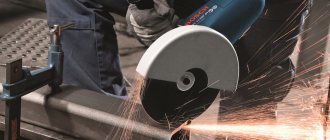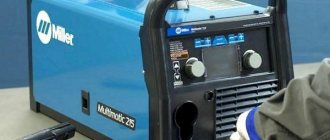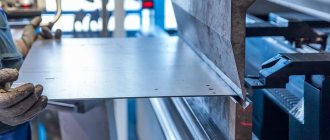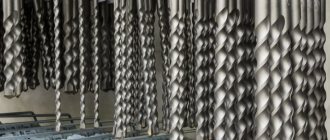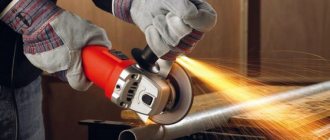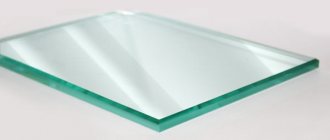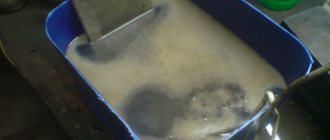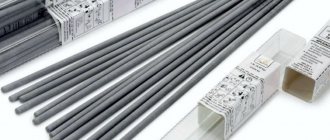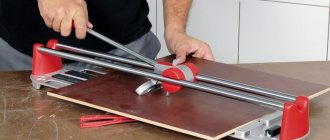What does it consist of?
The tool is a type of saw, designed for cutting metal. A hand hacksaw consists of a frame and a hacksaw blade. A frame is also called a frame or frame.
This part is equipped with a handle, a shank and a clamping element that secures the cutter. The handle can be made of different materials. Mostly wood or plastic is used. The frame can be solid or sliding. The second option allows you to work with canvases of different sizes. Structurally, the machine comes in the following types:
- with double-sided fastening of the cutting part (parameters are selected depending on the type of frame and its ability to adjust the length);
- with one-sided blade fixation (standard length 300 mm and shortened versions, width 13 mm).
The cutting element is a narrow metal strip, one side of which is decorated with teeth. Products are also available in which both sides have serrations. When using them, it is important not to confuse the used edge with the new one. The wedge-shaped teeth are made with a sharpening angle of 60 degrees. The pitch of the teeth depends on the purpose of the blade:
- for soft and tough metals – 1 mm;
- for hard metals – 1.5 mm;
- for mild steel – 2 mm.
For metalworking work, a blade is used on which there are 17 teeth with a pitch of 1.5 mm for every inch.
The tooth set can be straight or wavy. The first option involves placing sharp wedges along a straight line, the second - with the removal of every 2-3 teeth alternately to the left and to the right.
Parameters of blades for metal hacksaws:
- length – 150-400 mm;
- width – 10-25 mm;
- thickness – 0.6-1.25 mm.
For the manufacture of cutting elements, different steel alloys are used: alloyed, tool, cemented soft.
a circular saw
Sometimes a circular saw is used to cut metal. If you work with corrugated sheets, then the equipment must be turned on at low speeds. Otherwise, the polymer coating may be damaged. To work, you will need a partner who will hold the letter. Among the advantages of this tool, one can highlight the fact that the work is performed without heating, so you will NOT damage the protective coating on the profiled sheet. It is best to use an aluminum circle.
To get your circular saw working quickly, you need to prepare a plywood pattern. A groove is cut to the end in this sheet. This will be a kind of blank that allows you to preserve the galvanized or polymer coating on the sheet. An excellent tool for cutting metal is a double-blade saw. It, unlike the grinder, does not leave a torn edge and works much quieter. Unfortunately, not every master has such a tool.
Criterias of choice
There are a large number of hacksaws available on the market. Making a choice is not easy. To make the task easier, reference to important criteria that determine the purpose and effectiveness of a hand tool will help.
Manufacturer
A tool made by a well-known manufacturer is considered to be of higher quality and more durable. Products from the following brands deserve attention:
- STANLEY;
- STAYER;
- Vira;
- Gross;
- Kraftool.
What types of hacksaws are there for metal?
Hacksaw-handle for metal Bison 1572_z03
Household models . This is an affordable and common option. Used to perform simple tasks. Characterized by comfortable and simple use. The structures are most often equipped with additional screw mechanisms for tensioning the fabric. The handle is located longitudinally to the cutting element.
Professional models . Hacksaws are suitable for long-term work. The cut is accurate. The handle has a comfortable shape that allows you to use both hands during the cutting process. The rubberized coating of the handle prevents the tool from slipping during cutting. The blades can be installed at an angle, which ensures comfortable cutting of non-standard parts. Some models provide a choice of the desired angle from 2-3 possible options: 45/90/180 degrees.
Hacksaw-handle . The tool is characterized by a frame shape that resembles a bracket. Thanks to this solution, it is possible to cut workpieces in places inaccessible to conventional saws. The shape of the machine makes it possible to fix broken saw blades. A pen saw is ideal for creating internal cuts.
How to choose a hacksaw for metal
Processing material
With a hacksaw you can cut sheet and profiled metal, fittings and rods, metal pipes and corners. In repair and construction work, the tool is also used for cutting blanks made of plastic, chipboard, PVC, and plexiglass. They can be used to cut wooden parts and laminate.
Blade length, mm
This parameter is selected taking into account the dimensions of the part being cut. The larger it is, the longer the canvas should be. The length range of cutting elements for a hand saw varies from 150 to 400 mm. There is equipment whose length reaches 700 mm.
Teeth size
The teeth of the blade are small (up to 2.5 mm) and large (up to 5 mm). In products for working with metal, the average value is 2-2.5 mm. In wood saws, the teeth reach 4-6 mm. The more blades on the canvas, the smaller their size. This product makes it easier to cut hard metal. When working with soft alloy material, difficulties will be felt due to the rapid clogging of the blade with chips. This greatly slows down the work process and creates inconvenience.
A saw with fine teeth produces a more even, jagged cut. Cutting parts with a hacksaw with large teeth is faster, but there may be unevenness in the cut.
Industrial types of sheet metal cutting
Metal processing can be carried out in different ways. The specifics of the work depend on the type of equipment used for cutting metal sheets.
At large industrial enterprises, waterjet or thermal cutting is most often used.
1. Heat treatment of sheet metal.
Thermal cutting involves separating metal sheets with a jet heated to extreme temperatures. This type of cutting is also called non-contact cutting, since the tool does not interact with the surface of the sheet material.
Types of thermal cutting: oxygen gas, laser, plasma.
- Oxygen gas cutting of sheet metal.
Oxygen gas processing of sheet metal includes two stages:
- A jet of flame coming out of the cutter is supplied to the starting point of the intended cutting line. Acetylene is used as the working gas.
- After heating the material, the device supplies an oxygen flow, which easily cuts the softened metal. At the same time, oxides are removed.
In order for the cutting quality to be high, the distance between the cutter nozzle and the metal must be the same throughout the entire working process.
We recommend articles on metalworking
- Steel grades: classification and interpretation
- Aluminum grades and areas of their application
- Defects in metal products: causes and search methods
Oxygen cutting is the most economical cutting method and is excellent for cutting low alloy steels. If all the nuances of the technology are observed and the craftsman has sufficient experience, the edge of the sheet metal after oxy-fuel cutting does not require additional processing.
The disadvantage of using this type of cutting is that it can only process metals with low thermal conductivity.
- Plasma cutting of sheet metal.
Plasma cutting is considered a more universal method of processing sheet materials. The first equipment for this type of metal cutting appeared in the second half of the 20th century. The equipment was not only bulky, but also expensive, and therefore only large industrial enterprises could afford its acquisition and use. Over time, equipment has become more accessible, and the popularity of plasma cutting has grown exponentially.
VT-metall offers services:
In this case, metal processing is carried out using a high-speed plasma flow, the temperature of which can reach +30,000 °C. In this case, drops of molten metal formed as a result of melting are instantly blown away by a stream of compressed air. Compared to the previous type of cutting, plasma processing is highly productive, because the temperature of the oxygen gas flow is only +1,800 °C.
It is worth noting that the popularity of plasma cutting is explained not only by its high productivity, but also by a number of other important parameters. Thus, the work process does not require regular refilling of gas cylinders, additives for cutting valuable metals or increased attention to fire safety measures. To work with plasma equipment, you only need electricity and air, which allows you to draw objective conclusions about the simplicity, convenience and economy of the work process.
Plasma cutting of sheet metal can be used to process:
- aluminum and alloys based on it up to 120 mm thick;
- copper up to 80 mm thick;
- alloy and carbon steels up to 50 mm thick;
- cast iron up to 90 mm thick.
If the metal thickness exceeds 120 mm, it is more advisable to use oxy-fuel cutting.
When selecting the optimal equipment for metal processing, it is very important to take into account such properties as thickness and thermal conductivity. Here you need to remember one simple rule: the higher the thermal conductivity of the material being cut, the greater the heat removal and the smaller the possible thickness of the sheet being processed (for example, the thickness of a copper sheet should be less than a stainless steel sheet).
How to cut correctly with a hacksaw
It is not difficult to master the technique of cutting with a hacksaw for metal. It is important to adhere to the following recommendations.
How to cut metal with a hacksaw - the 21st century is in the yard
- The blade provides a cut only when moving forward. Therefore, physical efforts are exerted at these intervals. When returning to its original position, the pressure on the saw is relieved and the handle is slightly raised. Such manipulations extend the service life of the canvas.
- For work, you should choose a tool with a comfortable handle. Preference is given to U- and L-shaped forms. The handle in the form of a tubular stick slides when sawing and does not allow you to firmly fix the hacksaw with both hands.
- The installation of the blade is carried out taking into account the location of the teeth. They should be directed towards the carver (master).
- If a sliding model is used, you need to start installing the cutting element by adjusting the length of the tool taking into account the size of the blade.
- When installing the canvas, you need to pay attention to the tension. Over-tightening the cutting element can cause it to break at the slightest misalignment. If the tension is insufficient, it will be impossible to cut; the blade will continually slide off the surface of the material being processed.
- To avoid extreme heat, it is recommended to apply a few drops of oil to the cut area.
- When sawing a metal pipe or angle, there is no need to complete the cut. Sometimes the part being cut is simply broken by bending the sagging part. But you need to go through at least half the thickness of the workpiece with a hacksaw.
- To obtain an even cut, it is better to fix the part in a vice. This is especially important when working with pipes and angles.
- When working with hard metal, you need to exert great effort when moving the tool away from you. This will allow the prongs to sink into the flesh faster. The degree of force must be adjusted depending on the density of the workpiece used.
- If you need to cut thin sheet metal, it is clamped between two bars and fixed in a vice. The part is released only after cutting is completed.
Theoretically, you can cut quite thick metal with a hacksaw, but this will require a lot of effort and a lot of time. Therefore, massive workpieces are cut using alternative methods. And for pipes it is better to use a pipe cutter, since a regular blade for metal slides when passing through the cylinder, which can result in an uneven cut. Hand tools are capable of working with thick sheet metal, pipes, fittings, and rolled profiles.
Carpentry electric hacksaw
An electric carpentry saw cuts through a thicker sheet layer than a metal saw, for example, a steel sheet 12 mm thick and profile material 8 mm thick. This is explained by the higher power of the tool (on average about 550 W) and the longer stroke of the hacksaw blade.
Cutting speed
On an electric hacksaw, you can set the cutting speed that is optimally suited for a particular material, and thereby ensure the safety of the hacksaw blade. The use of a very flexible bimetallic blade allows cutting parts even flush with the wall surface. However, long straight cuts with an electric hacksaw are difficult to make.
Makes cutting easier
The hacksaw blade will glide better if it is wiped with a soap solution or a special emulsion to cool the cutting tools. In addition, oiled blades stay sharp longer and do not heat up as quickly.
The advantage of an electric carpentry saw is the ability to cut material, including metal, with a flexible narrow blade without rigidly fixing the tool itself.
Height alignment
After the setting has been completed, the hacksaw needs to be checked to ensure the same height of the teeth. Since the force may have been applied unevenly, there is a chance that teeth with less wear will appear that will protrude above the rest.
To identify such teeth on a hacksaw, you can use a simple method. It will require thick paper or cardboard along the length of the cutting blade. The sheet should be placed on a flat surface, such as a table, leveled well, and then the cutting part of the sheet should be pressed against it with force. Teeth that are out of alignment will make deeper indentations on the surface.
Thanks to this, they can be easily detected and corrected before sharpening begins. To remove excess height, various needle files are used. While performing this work, you should strive to preserve the shape of each hacksaw tooth as much as possible.
Pipe cutter
It is quite difficult to cut a pipe with a hacksaw accurately and accurately at right angles. And if these are thin-walled copper pipes, which are usually used when installing kitchen and plumbing equipment, then cutting them with a hacksaw is generally undesirable, since under the action of the spread saw teeth they are easily deformed, which, in turn, makes it impossible to tightly connect such pipes, which is usually done with a roller welding with crushing of edges.
Cutting roller
For cutting pipes - especially thin-walled ones - it is better to use a pipe cutter. Using a cutting roller, the pipe is brought with slight pressure to the guide roller, then a full turn is made with a pipe cutter. With each revolution, the cutting roller is carefully pressed. Repeat this operation until the pipe is cut.
Deburring
When cutting pipes with very thin walls, you should be extremely careful in adjusting the feed of the cutting roller: there is a risk of pushing through the wall. It is better to feed the roller to a shallow depth in a few revolutions than to try to cut with great force. A cut pipe will have burrs on the inside. They need to be carefully cleaned with a finely cut round file.
After each revolution of the tool around the pipe, it is necessary to adjust the position of the cutting roller using a manual spindle. Then cutting continues.
Sawing process
The work begins with installation. The hacksaw teeth should always point downwards, with the sharp ends away from the handle
Make sure that the fabric is tightened well enough, but it is also important not to overdo it, otherwise it may tear.
Use the entire length of the hacksaw to ensure the surface is erased evenly. Hold the saw arc firmly on both sides, preventing it from tilting in different directions.
Having made your choice, after purchasing, do not forget about proper operation and timely replacement of the blade, then the tool will maintain productivity for many years.
Sources:
https://elton-zoloto.ru/metalloobrabotka/kak-pravilno-zatochit-dvuruchnuju-pilu.html https://almois.ru/kak-pravilno-pilit-nozhovkoj-po-metallu/ https://armatool.ru /rucnaa-nozovka-po-metallu-kak-polzovatsa/
Jigsaw
If you need to cut a circle in a sheet of metal, you should use a jigsaw. It works quite quickly, so you will get a neat hole in a matter of minutes. Among the disadvantages of the equipment are noise and the possibility of a burnt edge when processing profiled sheets.
Subtleties of working with a jigsaw:
- it is necessary to use saws with fine teeth;
- you need to choose a reciprocating mode;
- it is necessary to control the inclination of the cutting part;
- rapid failure of consumables.
Preparing the hacksaw
Selection of hacksaw blade:
a) to cut soft metal, use hacksaw blades with large pitch s (16-18 teeth per 1 inch); for cutting thin strip metal - hacksaw blades with fine teeth (22-23 teeth per 1 inch), and for cutting the thinnest sheet metal - 24-32 teeth per 1 inch;
b) for metalworking work, they mainly use a hacksaw blade with a pitch of s = 1.5 mm, in which there are approximately 17 teeth on a length of 25 mm;
c) for long sawing, use hacksaw blades with large pitches, and for short sawings, with small pitches;
d) hacksaw blades are produced with a sharpening angle of 43-60°. To cut harder metals, use blades with a larger sharpening angle, and to cut softer metals, use blades with a smaller angle. Blades with a large sharpening angle are more wear-resistant.
Installing the hacksaw blade in the head slot:
a) insert hacksaw blade 1 into the slots of the machine head so that the teeth are directed away from the handle (Fig. c), and not towards the handle;
b) install the holes in the hacksaw blade exactly opposite the holes in the head of the hacksaw machine;
c) the front shank 4 must protrude from the head 3 by 10-12 mm to allow the web to be tensioned;
d) pin 2 should fit into the slot of head 3 (Fig. b);
e) insert pins 2 into the hole of the head and blade, the diameter of which must correspond to the diameter of the holes.
Hacksaw blade tension:
a) tension the hacksaw blade manually without much effort (the use of pliers or hand vises is prohibited) by slightly rotating the knob 5;
b) check the degree of tension by lightly pressing your finger on the side of the canvas: if the canvas does not bend, then the tension is sufficient (Fig. d).
Note. Under no circumstances should you allow the blade to be stretched too tightly or too loosely, as this will lead to its breakage, so the assembled hacksaw must be checked.
When stretching the fabric, due to the danger of tearing the fabric, you must keep the hacksaw at some distance from your face or use a plexiglass shield.
Working position when cutting with a hacksaw
a) set the height of the vice according to your height - the right hand with a hacksaw should have an angle of 90° at the elbow. See the picture above.
b) stand in front of the vice freely and steadily, half-turn in relation to the jaws of the vice or to the axis of the object being cut
c) turn the body to the left from the vice at an angle of 45°
d) place your left leg slightly forward, approximately along the line of the object being cut, and rest your body on it
e) the right leg should be turned in relation to the left at an angle of 60-70°, while the distance between the heels should be 200-300 mm
Oval sanding machine
Processing and cutting of thick-walled profile products, as well as sheets with a thickness of more than 2 mm - this is the area of application of the angle grinder. Usually the work is carried out with support from the hand. For those who frequently cross-cut products, it is recommended to purchase a suitable stand.
Rigid fastening
Cutting material with a machine requires some skill and can only be done with the help of special grinding wheels. The workpiece must be securely fastened. During operation, do not allow the machine to tilt.
Safety
Operate an angle grinder only while wearing safety glasses, gloves and non-flammable clothing. You can use a dust mask and soundproofing headphones. If work is carried out in enclosed spaces, flammable substances should be isolated, as sparking occurs when cutting.
An angle grinder can cut the thickest profile material. The machine's capabilities are limited only by the diameter of the cutting wheel.
Chisel
Work such as, for example, punching holes in thick sheets, cutting off rusty nuts, cutting thick wire, is best done with a chisel.
The blade of the tool should have a sharpening angle of 40-60 degrees, be sharply sharpened and well-hardened. If the cutting edge becomes dull or deformed after just a few blows, the tool is clearly unsuitable for further work.
The most commonly used are flat chisels and cross-cutters. The cutting part of a flat chisel has the same width as the handle. In the Kreutz Meisel, the blade is located across the handle and is much narrower. To cut out curved openings, the blade can be slightly sharpened along the edges, giving it a convex shape.
Follow safety rules
When working with a chisel, wear safety glasses: flying pieces of metal can seriously injure your eyes! It is also necessary to work on a thick (15-20 mm) steel lining and be sure to use gloves.
The chisel is placed on the marking line with a slight inclination - under the blow of the hammer, the blade cuts through the material.
